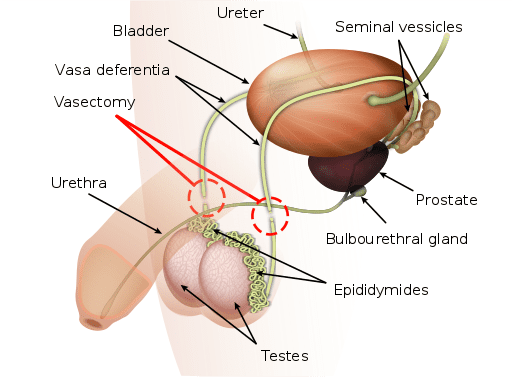Vasectomy is a form of birth control for men that is becoming more popular over time. It is the most common non-diagnostic operation that urologists in the U.S perform.[1] Approximately half a million men undergo vasectomies every year in this country. That is about 5% of all married men of reproductive age.[2]
It is a permanent form of birth control that involves a minor surgical procedure to seal the vas deferens so that sperm does not reach the semen. A vasectomy is over 99% effective in the long run. Per Penn Medicine, only 1-2 women per 1,000 get pregnant within a year after their partner has a vasectomy.[3] Further, the procedure has a number of great benefits for both men and women.
Why vasectomy is a better choice for men
A vasectomy is a reliable form of birth control that helps prevent unplanned pregnancy. Read on to learn about the benefits it provides, specifically for men. Benefits for women are covered later in the article.
-
Effective
A vasectomy is one of the most effective forms of birth control. According to the Urological Association guidelines [1] the risk of pregnancy after vasectomy is approximately 1 in 2,000 for men who have a sperm count of zero in a post-vasectomy semen analysis. This is equivalent to the contraceptive effectiveness of tubal ligation.
-
Easy procedure
This 20-30 minute procedure is almost always done in a doctor’s office rather than in an operating room. If the patient is anxious, oral or intravenous sedation can be administered. Then, the scrotum is cleaned with an antiseptic (sometimes shaving is required). After the vas deferens are located, a local anesthetic is injected to numb the area.
The doctor then makes one or two small openings in the scrotum through which the two vas deferens tubes are cut. Both ends of the severed vas deferens are then tied, stitched, or otherwise sealed. Sometimes electrocautery is used to seal the ends with heat. Scar tissue as a result of the surgery will block the tubes. The vas deferens are then returned to the scrotum and the skin openings are closed with resorbable sutures.[4]

Photo attribution: Author: K. D. Schroeder. Vasectomy diagram-en.svg from Wikimedia Commons. License: Creative Commons Attribution-ShareAlike 3.0
Unlike tubal ligation, a vasectomy does not require going under general anesthesia.
-
Reversible
While a vasectomy is a reliable form of birth control to prevent unplanned pregnancy. However, it can be reversed should a couple desire to have children after the procedure. Modern approaches utilize microsurgical techniques, robotic-assisted surgery, and video microsurgery.[5]
Between 6-10% of men choose to reverse their vasectomy. And, reversals tend to be successful [6], ranging from a 30-90% success rate depending on the type of procedure and other factors [6].
-
Lower health risks
Vasectomy patients have lower surgical risks than women who undergo tubal ligations. One reason is that a vasectomy avoids risks associated with general anesthesia.
A vasectomy is also a less invasive procedure, lowering the risk of bleeding and infection. Lastly, vital organs are not exposed, unlike in a tubal ligation.
-
Lower cost
A vasectomy is one of the most cost-effective forms of contraception. The average cost of the procedure is far less expensive than the sterilization methods for women, such as tubal ligation. This shouldn’t be a surprise because the procedure is performed in a doctor’s office instead of an operating room. Further, general anesthesia is not required.
-
One-time cost
A vasectomy is a permanent choice of birth control. This means it is just a one-time expense. While other contraceptives like condoms or pills may have a cheaper initial cost, the total cost accrues with each purchase.
Years of using oral contraceptives and condoms become more expensive over time [4]. For couples who no longer want to have children, a vasectomy is the most cost-effective option.
-
Often covered by insurance
Not only are vasectomies a one-time cost, but this cost is usually covered fully or in part by health insurance (after any co-pay or deductible).
-
Does not affect sexual pleasure
Although many studies on the correlation between sexual pleasure and vasectomies are poorly defined, men reported [1] that they did not experience negative effects on sexual function. Approximately, 98-99% of men were satisfied with the results of their vasectomies. Evidence also shows that a man’s orgasm does not change after a vasectomy.
Related content: How to Delay Age-Related Erectile Dysfunction
-
Fast recovery
Men may experience minor symptoms [7] after a vasectomy including bruising, swelling, and pain after the procedure. However, those symptoms typically only last for a few days.
According to the American Urological Association, only 1-2% of men experience chronic scrotal pain.[1] After getting a vasectomy, a patient needs to rest for 24 hours and abstain from sexual activity for a week. This recovery time is much shorter than tubal ligation, which may take from one to two weeks.
-
No-scalpel vasectomies available
To speed up recovery time, a no-scalpel vasectomy procedure has been developed.[8] First introduced to the United States in 1984, it relies on specialized surgical instruments, not scalpels, to expose the vas deferens. This option is less invasive and has fewer risks associated with it including less bleeding, infection, and pain.
Why vasectomy is a better choice for women
While vasectomies are performed on males, they provide a number of benefits to female partners as well. Although tubal ligation is still a more popular form of permanent birth control [1], read about some of the benefits a vasectomy offers specifically to women.
-
Stop hormonal birth control
While each woman reacts differently to oral contraceptives, the pill typically results in exaggerated mood changes. If her partner undergoes a vasectomy, a woman can avoid taking hormonal pills and can effectively regulate her mood better. A vasectomy also removes the constant worry of trying to remember a daily pill.
-
Avoid tubal ligation
As mentioned, tubal ligation is a much more invasive procedure than a vasectomy. There are greater risks, a longer recovery time, and a higher cost associated with tubal ligation.[1]
A vasectomy prevents a woman from having to undergo this invasive procedure, going to the operating room, and being put under general anesthesia. Because of these risks, a vasectomy is actually safer than tubal ligation.
-
Prevent risks of female sterilization
Female sterilization is associated with an increased risk of ectopic pregnancy in which the baby develops outside the womb. Vasectomy avoids exposing women to the increased risk of this serious pregnancy complication.
The bottom line when it comes to vasectomy
A vasectomy has many benefits for both men and women. The decision to undergo this procedure is a very personal one and, of course, should be discussed between the couple. Consult a doctor if you are considering this procedure or if you have any further questions.
References:
-
-
- The American Urologic Association. Vasectomy Guidelines (2015) https://www.auanet.org/guidelines/vasectomy-guideline – accessed 11/17/20.
- The Cleveland Clinic. Vasectomy (Male Sterilization). https://my.clevelandclinic.org/health/treatments/4423-vasectomy-sterilization# – accessed 11/17/20.
- Penn Medicine. 7 Things You Didn’t Know About Vasectomies. March 2019. https://www.pennmedicine.org/updates/blogs/health-and-wellness/2019/march/7-things-about-vasectomies – accessed 11/17/20.
- Procedure description adapted from Cigna. Vasectomy Surgical Overview – accessed 11/17/20 https://www.cigna.com/individuals-families/health-wellness/hw/medical-topics/vasectomy-hw7265 – accessed 11/17/20.
- American Society of Reproductive Medicine. Vasectomy Reversal: Contemporary Techniques. https://www.fertstert.org/article/S0015-0282(19)30009-3/fulltext#secsectitle0030 – accessed 11/17/20.
- Mayo Clinic. Vasectomy reversal. https://www.mayoclinic.org/tests-procedures/vasectomy-reversal/about/pac-20384537 – accessed 11/17/20.
- Mayo Clinic. Vasectomy. https://www.mayoclinic.org/tests-procedures/vasectomy/about/pac-20384580 – accessed 11/17/20.
- Medscape. No Scalpel Vasectomy (updated Jan 19, 2016) https://emedicine.medscape.com/article/148512-overview – accessed 11/17/20.
- Medical News Today. Is Pregnancy After Tubal Ligation Possible? https://www.medicalnewstoday.com/articles/323044#is-pregnancy-after-tubal-ligation-possible – accessed11/17/20.
-
Published on 2/5/17. Reviewed and updated 3/25/19, 11/17/20.
Parviz K. Kavoussi, MD
Website:
https://www.austinvasectomycenter.com/
Dr. Parviz Kavoussi holds academic positions as Adjunct Assistant Professor at the University of Texas at Austin and in the Department of Urology at the University of Texas Health Sciences Center at San Antonio, where he teaches residents training in urology; helps guide best clinical practices in male fertility in his position on the American Society of Andrology Public Affairs and Policy Committee; and is an expert peer reviewer for multiple scientific medical journals. Dr. Kavoussi runs the Austin Center for Vasectomy & Vasectomy Reversal and is the leading and only specialty fellowship trained Vasectomy Urologist in Austin, TX.
Comments:
Leave a Reply
Comment will held for moderation










Vasectomy is seriously nothing compared to chilbirth, whether it is C section or vaginal childbirth. Which every woman is just expected to go through without complaining number of times in her life. The chances of having post vasectomy issues are like less than 1% , while after childbirth they are 100%, where 9 in 10 women even have to get stitches in the vagina, that too when they might not want it. So if your partner and you dont wanna have kids , just really choose vasectomy, the woman has already been menstruating her whole life and riding the rollecoaster of estrogen.
Other wise, stop saying things like , if I could I would never let you hurt🙄. Actions speak louder than words!
Just a heads up. There can be complications with vasectomies. I experienced extreme pain during the procedure, performed by a urologist, that developed into chronic pelvic pain. The burning pain in my pelvic area never subsided even after visits to University Hospital in Madison, WI and Mayo Clinic. Typically urologists are the gatekeepers when pain exists in this area of the body. This debilitating pain existed in my life for 30 years until I saw an article on “Pelvic Pain”. I strongly recommend reading a book titled “A Headache in the Pelvis” that describes the Wise-Anderson Protocol, sometimes called the Standford Protocol. This book covers treatment for people with pelvic pain and related symptoms developed by Dr.Rodney Anderson and Dr.David Wise at Stanford University in the Department of Urology.
The first question asked by Dr. Wise was, “Did you experience an event that precipitated this condition?” My answer was “extreme pain immediately during and after a vasectomy procedure”.
I have been informed that Pelvic Pain Syndrome is now contained in the curriculum of urological medicine in the United States.
@Joe
As you found out the hard way, vasectomy has a 1-2% chance of chronic scrotal pain, which can lower your quality of life. Doctors do not have any reliable cure or treatment for this condition, and they usually do not disclose the existence of post vasectomy syndrome to their patients prior to operating. They may euphamistically refer to a “small” chance of “long term discomfort” or something along those lines and say that if it comes up you should come back and “we’ll get you fixed up.”
Spoiler alert, they will not be able to get you fixed up. They will try putting you on tricyclics and when that doesn’t work they will recommend surgically removing your epididymis.
Urologists love to say that vasectomy cannot affect your sex life, but if you read the fine print you will see that there is a real chance of permanent, incurable pelvic pain. Something doesn’t add up there.
My husband and I chose the Vasectomy procedure and after taking in a sample 1 month post surgery and it being clear and then again 4 months post and it coming back clear we ended up pregnant 7 months post his surgery. 3 month post his last cleared sample! Doctor was completely speechless as to what happened! After finding out I was pregnant post “successful” vasectomy he went back in to leave another sample and doctor found 2 live sperm! Was a situation We never want to go through again! We chose a vasectomy because of it being so successful but we learned the hard way!
Oh my, such a shocking way to learn that nothing in medicine is perfect.
I believe the reversal bit is a little overstated. And if I am going to have a permanent mutilation just to help my wife out, then I will suggest she also gets Tubal Ligation so that just in case my vasectomy fails, hers will act as a back up. Secondly I believe once we both know we are mutilated for life. We will stick together till death do us part. How about that for a life time partnership
Twisted controlling fuckwit, I hope she leaves you first rather than risk serious complications and have an unnecessary general anesthetic.
It’s interesting to know that the risk of pregnancy is practically none after vasectomy. My husband and I are looking for the best birth control, and he suggests vasectomy. Since we already have two kids and we do not want more, I believe that vasectomy will be the perfect option for us.
Seth- Wow, let me just say women don’t just get a little moody on birth control. Birth control doesn’t even allow a woman to have a regular period. The women on birth control have not had a regular period made by their body since they started taking them. It’s a false period. That’s sounds awesome right? Also they have a lot of risks with them. Blood clots, strokes etc. Plus the time it takes her body to readjust after being on birth control for countless years can take a pregnancy up to 16 years to happen.The other forms of birth control for women have even more risks but that’s okay right? Having a IUD grow into your uterus and possibly taking your life well… as long as if your man leaves he can still have babies than who cares what women want? You really should do some research on birth control and its risks before deciding what you actually know. All men with this kind of mentality should only be in relationships with other men. Problem solved no babies and no women with upper hands.